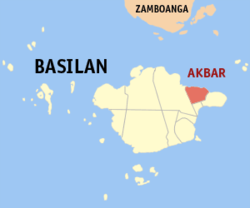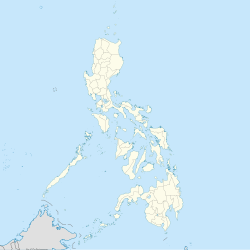Akbar, Basilan
Akbar
اكبر | |
|---|---|
| Municipality of Akbar | |
 Map of Basilan with Akbar highlighted | |
Location in the Philippines | |
| Coordinates: 6°39′54″N 122°11′43″E / 6.665111°N 122.195161°E | |
| Country | Philippines |
| Region | Bangsamoro Autonomous Region in Muslim Mindanao |
| Province | Basilan |
| District | Lone district |
| Founded | December 20, 2005 |
| Barangays | 9 (see Barangays) |
| Government | |
| • Type | Sangguniang Bayan |
| • mayor of Akbar[*] | Alih A. Sali |
| • Vice Mayor | Raiza A. Sali |
| • Representative | Mujiv S. Hataman |
| • Municipal Council | Members |
| • Electorate | 7,514 voters (2022) |
| Area | |
• Total | 38.76 km2 (14.97 sq mi) |
| Elevation | 55 m (180 ft) |
| Highest elevation | 999 m (3,278 ft) |
| Lowest elevation | 0 m (0 ft) |
| Population (2020 census)[3] | |
• Total | 23,098 |
| • Density | 600/km2 (1,500/sq mi) |
| • Households | 3,621 |
| Economy | |
| • Poverty incidence | 64.88 |
| • Revenue | ₱ 86.33 million (2020) |
| • Assets | ₱ 100.9 million (2020) |
| • Expenditure | ₱ 82.62 million (2020) |
| • Liabilities | ₱ 37.52 million (2020) |
| Service provider | |
| • Electricity | Basilan Electric Cooperative (BASELCO) |
| Time zone | UTC+8 (PST) |
| ZIP code | 7306 |
| PSGC | |
| IDD : area code | +63 (0)62 |
| Native languages | Yakan Chavacano Tagalog |
Akbar, officially the Municipality of Akbar (Tausūg: Lupah Akbar; Chavacano: Municipalidad de Akbar; Tagalog: Bayan ng Akbar), is a municipality in the province of Basilan, Philippines. According to the 2020 census, it has a population of 23,098 people, making it the least populated municipality in the province.[3]
History
[edit]Akbar was created through Muslim Mindanao Autonomy Act No. 193 dated December 20, 2005.[5]
It is composed of 9 barangays that were formerly part of Tuburan, including one island barangay. It has an area of 38.76 square kilometres (14.97 sq mi).[6]
The place is named after Imam Akbar Marani, a known Islamic preacher/propagator and descendant of Kuddarat, who landed in Taguime (now part of the municipality of Moh’d Ajul) in 17th century and later migrated to central Mindanao. In his older age, Imam Akbar transferred from Sinangkapan, Akbar, to Lantawan based in Kanibungan and he was buried there.
Geography
[edit]Barangays
[edit]
Akbar is politically subdivided into 9 barangays.[7] Each barangay consists of puroks while some have sitios.
| PSGC | Barangay | Population | ±% p.a. | |||
|---|---|---|---|---|---|---|
| 2020[3] | 2010[8] | |||||
| 150708001 | Caddayan | 4.7% | 1,090 | 569 | 6.72% | |
| 150708002 | Linongan | 10.6% | 2,454 | 1,938 | 2.39% | |
| 150708003 | Lower Bato-bato | 7.9% | 1,823 | 1,885 | −0.33% | |
| 150708004 | Mangalut | 6.9% | 1,603 | 1,152 | 3.36% | |
| 150708005 | Manguso | 5.2% | 1,201 | 1,051 | 1.34% | |
| 150708006 | Paguengan | 7.1% | 1,649 | 1,280 | 2.56% | |
| 150708007 | Semut | 19.4% | 4,483 | 3,168 | 3.53% | |
| 150708008 | Upper Bato-bato | 4.7% | 1,093 | 642 | 5.46% | |
| 150708009 | Upper Sinangkapan | 9.2% | 2,135 | 1,684 | 2.40% | |
| Total | 23,098 | 13,369 | 5.62% | |||
Climate
[edit]| Climate data for Akbar, Basilan | |||||||||||||
|---|---|---|---|---|---|---|---|---|---|---|---|---|---|
| Month | Jan | Feb | Mar | Apr | May | Jun | Jul | Aug | Sep | Oct | Nov | Dec | Year |
| Mean daily maximum °C (°F) | 27 (81) |
27 (81) |
27 (81) |
28 (82) |
28 (82) |
28 (82) |
28 (82) |
28 (82) |
28 (82) |
28 (82) |
28 (82) |
28 (82) |
28 (82) |
| Mean daily minimum °C (°F) | 27 (81) |
26 (79) |
27 (81) |
27 (81) |
28 (82) |
28 (82) |
27 (81) |
27 (81) |
27 (81) |
28 (82) |
27 (81) |
27 (81) |
27 (81) |
| Average precipitation mm (inches) | 106 (4.2) |
77 (3.0) |
91 (3.6) |
104 (4.1) |
236 (9.3) |
321 (12.6) |
325 (12.8) |
306 (12.0) |
227 (8.9) |
271 (10.7) |
204 (8.0) |
115 (4.5) |
2,383 (93.7) |
| Average rainy days | 15.3 | 13.8 | 17.7 | 15.5 | 23.1 | 24.5 | 24.3 | 24.6 | 21.1 | 22.9 | 20.1 | 16.6 | 239.5 |
| Source: Meteoblue (modeled/calculated data, not measured locally)[9] | |||||||||||||
Demographics
[edit]| Year | Pop. | ±% p.a. |
|---|---|---|
| 2007 | 21,312 | — |
| 2010 | 13,369 | −15.61% |
| 2015 | 17,531 | +5.30% |
| 2020 | 23,098 | +5.57% |
| Source: Philippine Statistics Authority[10][8][11][12] | ||
In the 2020 census, Akbar had a population of 23,098.[3] The population density was 600 inhabitants per square kilometre (1,600/sq mi).
Economy
[edit]Poverty Incidence of Akbar
10
20
30
40
50
60
70
80
2006
41.40 2009
32.70 2012
53.92 2015
52.06 2018
70.12 2021
64.88 Source: Philippine Statistics Authority[13][14][15][16][17][18] |
References
[edit]- ^ Municipality of Akbar | (DILG)
- ^ "2015 Census of Population, Report No. 3 – Population, Land Area, and Population Density" (PDF). Philippine Statistics Authority. Quezon City, Philippines. August 2016. ISSN 0117-1453. Archived (PDF) from the original on May 25, 2021. Retrieved July 16, 2021.
- ^ a b c d Census of Population (2020). "Bangsamoro (BARMM)". Total Population by Province, City, Municipality and Barangay. Philippine Statistics Authority. Retrieved 8 July 2021.
- ^ "PSA Releases the 2021 City and Municipal Level Poverty Estimates". Philippine Statistics Authority. 2 April 2024. Retrieved 28 April 2024.
- ^ "Muslim Mindanao Autonomy Act No. 193; An Act Creating the Municipality of Akbar in the Province of Basilan and for Other Purposes" (PDF). Regional Legislative Assembly, Autonomous Region in Muslim Mindanao. Archived from the original (PDF) on 4 February 2016. Retrieved 19 January 2021.
- ^ "The Comprehensive Development Plan - Municipality of Akbar". basilan.net. Provincial Government of Basilan. Archived from the original on 15 March 2016. Retrieved 19 January 2021.
- ^ "Municipal: Akbar, Basilan". PSGC Interactive. Quezon City, Philippines: Philippine Statistics Authority. Retrieved 8 January 2016.
- ^ a b Census of Population and Housing (2010). "ARMM – Autonomous Region in Muslim Mindanao" (PDF). Total Population by Province, City, Municipality and Barangay. National Statistics Office. Retrieved 29 June 2016.
- ^ "Akbar, Basilan : Average Temperatures and Rainfall". Meteoblue. Retrieved 29 January 2019.
- ^ Census of Population (2015). "ARMM – Autonomous Region in Muslim Mindanao". Total Population by Province, City, Municipality and Barangay. Philippine Statistics Authority. Retrieved 20 June 2016.
- ^ Censuses of Population (1903–2007). "ARMM – Autonomous Region in Muslim Mindanao". Table 1. Population Enumerated in Various Censuses by Province/Highly Urbanized City: 1903 to 2007. National Statistics Office.
- ^ "Province of Basilan". Municipality Population Data. Local Water Utilities Administration Research Division. Retrieved 17 December 2016.
- ^ "Poverty incidence (PI):". Philippine Statistics Authority. Retrieved December 28, 2020.
- ^ "City and Municipal Level Poverty Estimates; 2006 and 2009" (PDF). Philippine Statistics Authority. 3 August 2012.
- ^ "2012 Municipal and City Level Poverty Estimates" (PDF). Philippine Statistics Authority. 31 May 2016.
- ^ "Municipal and City Level Small Area Poverty Estimates; 2009, 2012 and 2015". Philippine Statistics Authority. 10 July 2019.
- ^ "PSA Releases the 2018 Municipal and City Level Poverty Estimates". Philippine Statistics Authority. 15 December 2021. Retrieved 22 January 2022.
- ^ "PSA Releases the 2021 City and Municipal Level Poverty Estimates". Philippine Statistics Authority. 2 April 2024. Retrieved 28 April 2024.
External links
[edit]- Akbar Profile at the DTI Cities and Municipalities Competitive Index
- Philippine Standard Geographic Code



